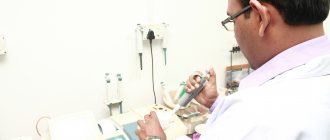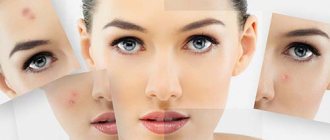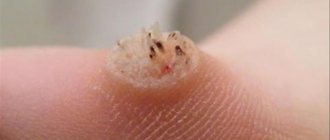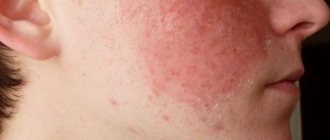Warts on the face are a fairly common pathology of the skin, in most cases they do not cause pain.
However, these neoplasms can manifest themselves as obvious cosmetic defects, thereby bringing pronounced psychological discomfort to the wearer. These growths are areas of overgrown epithelial tissue that rise above the skin in tubercles of different ethologies.
Depending on the type of pathology, warts have certain characteristics: they have different consistencies, sizes, and colors. There are many ways to get rid of unpleasant skin growths. It is not recommended to get rid of warts on your own, since they can develop dangerously (even oncologically). Therefore, before removing the tumor, you should consult a dermatologist.
Types of warts
There are many types of warts that can be found on the face. And now about each type in detail.
The common wart can reach 1.5 cm in diameter and rise up to 2 mm above the skin, its color blends with the skin. They can occur in a person of any age category.
The wart is flat, no more than 1 cm in diameter, and the color can vary from skin color to brown. Similar growths appear in adolescents.
A filamentous wart forms on the eyelid; its size can vary, as can its color.
Age-related keratomas are warts that do not depend on the virus entering the body. They are formed in older people, the size can reach up to 2 cm, the color is mainly brown or black.
Colorless warts are white in color and range in size from 0.5 cm to 2 cm in diameter.
Large warts are the fusion of several into one. The sizes can be quite large, the color is beige, dark brown is possible.
If it is difficult to determine from the description what type of tumor you have, pay attention to the photo of warts that may appear on the face below. But in any case, you need to contact a dermatologist to prescribe the correct treatment for the wart.
Diagnostics
Based on the appearance of the growth, it becomes clear that this is a senile wart. However, before removing age-related keratomas, the growth should be examined. It must be distinguished from other types of keratomas, neoplasms caused by HPV, and melanoma.
The main diagnostic method is biochemical analysis. To carry it out, you need a biopsy - taking a fragment. To exclude HPV as the root cause of the formation of a neoplasm, sometimes PCR is needed - diagnostics that can exclude the DNA of the pathogen in keratoma cells or show its absence.
Treatment methods
There are three methods of getting rid of warts: using products from the pharmacy, folk remedies, and in a beauty salon. Let's consider all the methods, and you will already decide what will be more effective for you in the fight against warts on the face.
Causes
The reasons for the formation of senile keratomas have not been established for certain. What is known is that they are completely different from warts (an abnormal growth of skin cells that is caused by HPV). The formation of these growths is influenced by the following factors:
- Excessive solar radiation. Large amounts of ultraviolet radiation negatively affect human skin.
- Inadequate diet and resulting deficiency of vitamins and minerals.
- Seborrhea. A skin condition caused by increased activity of the sebaceous glands.
- Frequent trauma to the skin either mechanically or through chemicals.
- Genetic predisposition.
The origin of senile keratomas is not viral. They are formed as a result of age-related malfunctions of the skin. Everyone is susceptible to the disease, regardless of gender.
Drug treatment
It is quite difficult to choose the right medications, since today there is a huge selection of different medications for such a disease. A large variety of creams, ointments, tablets, powders and suspensions.
It is advisable to use these medications together in order to get a quick effect from the treatment. The most popular remedies for papillomas are Vartek cream, Aldara, oxolinic ointment, Viferon, and Wartner aerosol.
Treatment of warts with folk remedies
When a wart appears, many people wonder whether it is possible to remove it on the face at home? Yes, but with great caution, all responsibility for the consequences falls on you.
Folk remedies need to wipe the tumor, for example, tea tree oil, onion juice, castor or linseed oil. Sometimes such treatment helps, but you don’t need to rely on it 100%.
Traditional methods
The safest and most effective way to remove and treat warts on the face is cryotherapy, laser coagulation, electrocoagulation, radio wave therapy, chemotherapy and surgical excision. Details about each.
Cryotherapy is a procedure that uses liquid nitrogen to burn warts. The advantages are the speed of manipulation and bloodlessness, but the disadvantage is that it is impossible to send an analysis to determine whether the tumor is benign.
Laser coagulation is a procedure for removing warts using a laser. This is one of the most inexpensive procedures, which is a significant plus. With this method, you can get rid of several warts at once; there are contraindications for this procedure, firstly, the presence of diabetes, HIV infection and oncology.
Electrocoagulation - this procedure involves the interaction of warts with high frequency current. After it is carried out, there are no traces of early neoplasm, but infection is possible, which can have a very bad effect on human health.
Radio wave therapy is a procedure using a radio wave device that will rid your face of a wart in 1 minute. This procedure is contraindicated for pregnant women with various types of heart disease, diabetes, and epilepsy.
Chemotherapy is a procedure designed for flat-shaped warts. Acids are taken and applied to the formations. The advantage is the absence of recurrence of this problem in this place. This method is not effective for large warts.
Surgical excision is a last resort method when none of the above is suitable. A similar manipulation is performed if the wart is very large; the surgeon removes it and applies stitches. There are no contraindications to this procedure, but long-term recovery is possible.
As you can see, there is a wide variety of methods for removing warts on the face, there is plenty to choose from. But we advise you to first contact a qualified specialist who will prescribe the correct treatment and give advice on what you can supplement with folk remedies.
Forms
According to numerous observations of neoplasms, it was possible to identify five forms of wart development with different characteristics.
- The spotted form begins to develop from small brown spots. If the location is the face, then a pink or yellow color is possible. At this stage, the spots do not cause any discomfort; their shape is not yet clearly defined. In most cases they have a smooth surface, but minor roughness is allowed; elevation above the skin does not yet occur. One or more spots with increased pigmentation may appear.
- The follicular (nodular) stage is characterized by the first signs of elevation above the skin. Keratomas grow slowly, but the dynamics remain. Externally, they look like gray or dark gray formations of irregular shape. During this period, the first scales may appear, but they are practically invisible, because still adhere very tightly to the underlying layers.
- The plaque (keratonic) form is determined by the formation of senile keratomas. They look like a gray-brown plaque with a dense crust and clearly defined boundaries. The height of the growth at this time is several millimeters. If you scrape off the crust that has formed, you will find a bleeding surface underneath.
- The seborrheic stage involves the process of combining several growths into one. Cracks form at the place where their border was. During this period, the process of warts spreading throughout the body is most active. The surface of the plaques peels off, and the scales that have fallen off the top layer may fall off. As a result, the tumor begins to bleed and may become inflamed and itchy, causing discomfort to the patient. The seborrheic stage of wart development requires mandatory consultation with a specialist.
- The cutaneous horn is the final stage of growth development. At this time, it is completely covered with horny accumulations, protruding significantly above the skin. Its color is dark or even black. If the wart matures before this stage, it is imperative to find out the nature of the neoplasm (benign or malignant). This is due to the fact that such a growth may conceal a squamous cell cancer.
Types of senile warts.
Photo of warts on the face
We also recommend:











